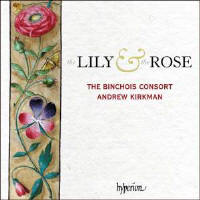Texte paru dans: / Appeared in: |
|
|
Outil de traduction ~ (Très approximatif) |
|
|
Reviewer: James
V. Maiello This disc continues a rich exploration of the intersections between English music and alabaster church sculpture begun in the Binchois Consort’s 2016 album Music for the 100 Years’ War. Andrew Kirkman has conceived an intellectually invigorating program of Marian polyphony by a varied roster of English composers of the long 15th century. Kirkman is one of the finest scholars of early music anywhere, and the liner essay, co-authored with musicologist Philip Weller, is erudite, thought-provoking, and lucid. It is amplified by high-quality photos of the alabaster images that parallel the music.
The recording coalesces around four Marian themes, the first of which is the Virgin’s intercession against plague. Motets form the core of the program, beginning with John Cooke’s setting of Stella celi extirpavit. Here, the singers set a very high standard immediately, rendering lines with tranquil clarity. Dunstable’s polytextual motet Gaude virgo salutata / Gaude virgo singularis / Virgo Mater comprobaris / Ave gemma celi is a tour de force for both composer and performers, a highlight of the section on the Annunciation. The four Latin texts and swirling lines are disorienting, but the ensemble manages to bring everything together cohesively. Moreover, the treble voices are even and refined in higher passages, allowing for a restrained suavitas. Obscure composers like Damett, Forest, and Fowler are an especially welcome addition to the program. Forest’s Qualis est dilectus is a particular revelation, with a Dunstable-esque sweetness. Frye’s Missa Flos regalis is the thread that connects the disparate sections of the program, interspersed throughout. The Mass is given a gentle, contemplative reading, the choir weaving Frye’s lines into an ethereal sonic fabric. Like so many English masses, the Kyrie of Frye’s is missing, so Kirkman has inserted Frye’s Kyrie “So ys emprentid” to round out the Mass. The plainchant items and sections are consistently fine throughout the disc, soothing, undulating, with a meditative coolness that is almost hypnotic. Indeed, they are some of the best parts of the recording. Taken as a whole, this is a wonderfully unified program, carefully planned and executed perfectly. With the liner essay, it is an immersive experience, using visual art and music to explore medieval spirituality and aesthetics. At the same time, the album stands on its own merits as one of the best early music recordings I have heard in recent years. To sweeten the deal, it includes the rarely heard music of several virtually unknown composers. I’d be very surprised if this disc didn’t garner at least a few awards. | |
|
Support us financially by purchasing this disc from eiher one of these suppliers. Un achat via l'un ou l'autre des fournisseurs proposés contribue à défrayer les coûts d'exploitation de ce site. |
|
|
|
|
|
Cliquez l'un ou l'autre
bouton pour découvrir bien d'autres critiques de CD |
|




